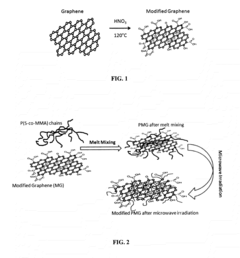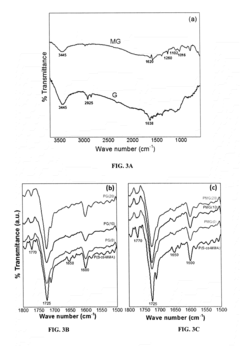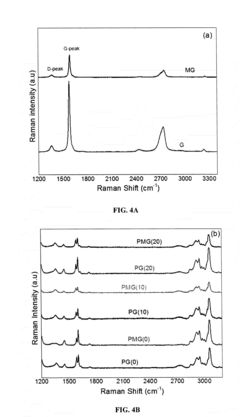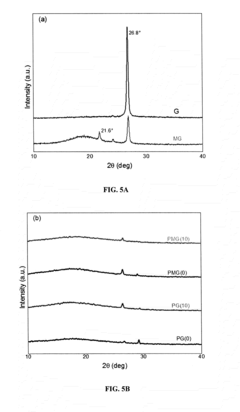Graphene Oxide as a Novel Antioxidant: Recent Studies
Graphene Oxide Research Background and Objectives
Graphene oxide (GO) has emerged as a groundbreaking material in the field of nanotechnology, with its unique properties attracting significant attention from researchers worldwide. The exploration of GO as a novel antioxidant represents a promising frontier in materials science and biomedical applications. This research aims to comprehensively examine the antioxidant properties of GO, its potential mechanisms of action, and its prospective applications in various industries.
The development of GO as an antioxidant is rooted in the broader context of graphene-based materials research. Since the isolation of graphene in 2004, scientists have been investigating its derivatives, including GO, for their exceptional physical and chemical characteristics. The oxidized form of graphene, GO, possesses a unique structure with abundant oxygen-containing functional groups, which contribute to its water dispersibility and reactivity.
Recent studies have revealed GO's remarkable antioxidant capabilities, surpassing those of many conventional antioxidants. This discovery has opened up new avenues for research in fields such as biomedicine, food preservation, and environmental remediation. The antioxidant properties of GO are attributed to its large surface area, high electron mobility, and the presence of various oxygen-containing functional groups that can scavenge free radicals effectively.
The primary objectives of this research on GO as a novel antioxidant are multifaceted. Firstly, it aims to elucidate the fundamental mechanisms underlying GO's antioxidant activity, including its interactions with different types of reactive oxygen species (ROS) and free radicals. Secondly, the research seeks to optimize GO's antioxidant performance through various modification techniques, such as functionalization or doping with other elements.
Furthermore, this study intends to explore the potential applications of GO-based antioxidants across diverse sectors. In the biomedical field, GO's antioxidant properties could be harnessed for developing new therapies for oxidative stress-related diseases or enhancing the efficacy of existing treatments. In the food industry, GO might serve as a potent preservative, extending the shelf life of perishable products. Environmental applications could include the use of GO in water treatment processes to neutralize harmful pollutants.
Another crucial aspect of this research is to assess the safety and biocompatibility of GO when used as an antioxidant, particularly in biological systems. This involves comprehensive toxicological studies to ensure that the benefits of GO's antioxidant properties outweigh any potential risks associated with its use.
By addressing these objectives, this research aims to contribute significantly to the understanding and utilization of GO as a novel antioxidant. The findings are expected to pave the way for innovative applications and potentially revolutionize various industries by offering a more effective and versatile alternative to traditional antioxidants.
Market Potential for Graphene Oxide-based Antioxidants
The market potential for graphene oxide-based antioxidants is rapidly expanding, driven by increasing awareness of the material's unique properties and its diverse applications across multiple industries. The global antioxidant market, valued at approximately $5.18 billion in 2020, is projected to grow at a CAGR of 6.8% from 2021 to 2028, with graphene oxide-based products poised to capture a significant share of this growth.
In the healthcare and pharmaceutical sectors, graphene oxide antioxidants show promise in drug delivery systems, tissue engineering, and as therapeutic agents for oxidative stress-related diseases. The biocompatibility and low toxicity of graphene oxide make it an attractive option for these applications, potentially leading to more effective treatments for conditions such as cancer, neurodegenerative disorders, and cardiovascular diseases.
The food and beverage industry presents another substantial market opportunity for graphene oxide antioxidants. As consumers become more health-conscious, there is a growing demand for natural and effective preservatives. Graphene oxide's ability to scavenge free radicals and extend the shelf life of food products without compromising taste or nutritional value positions it as a valuable alternative to traditional synthetic antioxidants.
In the cosmetics and personal care sector, graphene oxide-based antioxidants are gaining traction due to their potential anti-aging and skin protection properties. The global cosmetic products market, expected to reach $463.5 billion by 2027, offers a vast playground for innovative graphene oxide formulations in skincare, haircare, and sun protection products.
The industrial sector, particularly in coatings and packaging, represents another significant market for graphene oxide antioxidants. Their ability to enhance the durability and performance of materials while providing protection against oxidation and corrosion makes them attractive for use in automotive, aerospace, and electronics industries.
However, the market potential is not without challenges. Regulatory hurdles, particularly in food and healthcare applications, may slow down the adoption of graphene oxide-based antioxidants. Additionally, the relatively high production costs and the need for further research to fully understand long-term effects and optimize formulations could impact market growth in the short term.
Despite these challenges, the unique properties of graphene oxide as an antioxidant, combined with ongoing research and development efforts, suggest a promising future. As production techniques improve and costs decrease, the market for graphene oxide-based antioxidants is expected to expand significantly, potentially disrupting traditional antioxidant markets and opening new application avenues across various industries.
Current State and Challenges in Graphene Oxide Antioxidant Research
Graphene oxide (GO) has emerged as a promising antioxidant material, attracting significant attention in recent years due to its unique properties and potential applications. The current state of research in this field is characterized by rapid advancements and growing interest from both academia and industry.
One of the primary focuses of current research is understanding the mechanisms by which GO exhibits its antioxidant properties. Studies have shown that GO can effectively scavenge various reactive oxygen species (ROS) and free radicals, which are known to cause oxidative stress and cellular damage. The large surface area and abundant functional groups of GO contribute to its high antioxidant capacity.
Recent investigations have demonstrated the potential of GO as an antioxidant in various biological systems. In vitro studies have shown promising results in protecting cells from oxidative damage, while in vivo experiments have explored its efficacy in reducing oxidative stress in animal models. These findings have opened up new possibilities for GO applications in biomedical fields, including drug delivery, tissue engineering, and regenerative medicine.
However, the research on GO as an antioxidant faces several challenges. One major concern is the potential toxicity of GO, which needs to be thoroughly evaluated before widespread application. The long-term effects of GO exposure on biological systems and the environment are not yet fully understood, necessitating comprehensive safety assessments.
Another challenge lies in the standardization of GO production and characterization. The antioxidant properties of GO can vary significantly depending on its synthesis method, size, and functionalization. Developing consistent and reproducible methods for GO preparation and characterization is crucial for ensuring reliable and comparable research outcomes.
The bioavailability and biodistribution of GO in living organisms present additional challenges. Understanding how GO interacts with biological systems, its uptake mechanisms, and its fate in the body is essential for optimizing its antioxidant efficacy and minimizing potential side effects.
Furthermore, the scalability of GO production for commercial applications remains a significant hurdle. Current synthesis methods often involve complex processes and the use of hazardous chemicals, making large-scale production challenging and potentially environmentally unfriendly.
Researchers are also grappling with the challenge of enhancing the selectivity of GO's antioxidant activity. While its broad-spectrum antioxidant properties are beneficial in many contexts, developing methods to target specific ROS or cellular compartments could greatly improve its therapeutic potential.
In conclusion, while the current state of research on GO as a novel antioxidant is promising, significant challenges remain. Addressing these challenges will be crucial for realizing the full potential of GO in antioxidant applications and paving the way for its practical use in various fields.
Existing Antioxidant Solutions and Graphene Oxide Comparison
01 Antioxidant properties of graphene oxide
Graphene oxide exhibits strong antioxidant properties due to its unique structure and chemical composition. It can effectively scavenge free radicals and reduce oxidative stress in various applications, including biomedical, environmental, and industrial fields.- Antioxidant properties of graphene oxide: Graphene oxide exhibits strong antioxidant properties due to its unique structure and chemical composition. It can effectively scavenge free radicals and reduce oxidative stress in various applications, making it a promising material for use in antioxidant formulations and protective coatings.
- Graphene oxide-based antioxidant composites: Composites incorporating graphene oxide demonstrate enhanced antioxidant capabilities. These composites can be tailored for specific applications, such as food packaging, biomedical devices, and environmental remediation, by combining graphene oxide with other materials to create synergistic antioxidant effects.
- Functionalization of graphene oxide for improved antioxidant activity: Chemical modification and functionalization of graphene oxide can further enhance its antioxidant properties. Various functional groups and molecules can be attached to the graphene oxide surface, tailoring its reactivity and increasing its effectiveness in neutralizing free radicals and preventing oxidation.
- Applications of graphene oxide as an antioxidant in biological systems: Graphene oxide's antioxidant properties make it suitable for various biological applications. It can be used in drug delivery systems, tissue engineering, and as a protective agent against oxidative stress-induced cellular damage. The material's biocompatibility and ability to scavenge reactive oxygen species contribute to its potential in biomedical fields.
- Production methods for antioxidant graphene oxide: Various production methods have been developed to synthesize graphene oxide with enhanced antioxidant properties. These methods focus on controlling the oxidation level, sheet size, and surface chemistry of graphene oxide to optimize its antioxidant performance. Techniques such as modified Hummers method and green synthesis approaches are employed to produce high-quality antioxidant graphene oxide.
02 Graphene oxide-based antioxidant composites
Composite materials incorporating graphene oxide show enhanced antioxidant capabilities. These composites can be used in various applications such as protective coatings, packaging materials, and biomedical devices to prevent oxidation and extend the lifespan of products.Expand Specific Solutions03 Functionalization of graphene oxide for improved antioxidant activity
Chemical modification and functionalization of graphene oxide can further enhance its antioxidant properties. This includes attaching specific functional groups or molecules to the graphene oxide surface, tailoring its reactivity and effectiveness in various antioxidant applications.Expand Specific Solutions04 Graphene oxide in biomedical antioxidant applications
Graphene oxide's antioxidant properties make it suitable for various biomedical applications. It can be used in drug delivery systems, tissue engineering, and as a protective agent against oxidative stress-induced cellular damage, potentially benefiting treatments for various diseases.Expand Specific Solutions05 Graphene oxide-based sensors for antioxidant detection
The unique properties of graphene oxide enable the development of highly sensitive and selective sensors for detecting antioxidants and measuring antioxidant capacity. These sensors can be used in food quality control, environmental monitoring, and healthcare diagnostics.Expand Specific Solutions
Key Players in Graphene Oxide Research and Development
The research on Graphene Oxide as a novel antioxidant is in its early stages, indicating an emerging market with significant growth potential. The global antioxidant market is substantial, with increasing interest in novel materials. Technologically, Graphene Oxide is still developing, with varying levels of maturity across applications. Key players like The University of Manchester, Northwestern University, and South China University of Technology are at the forefront of research, while companies such as Global Graphene Group, Inc. and LG Electronics, Inc. are exploring commercial applications. The involvement of diverse institutions, from academic to industrial, suggests a competitive landscape with opportunities for innovation and market expansion.
Centre National de la Recherche Scientifique
Alma Mater Studiorum - Università di Bologna
Core Innovations in Graphene Oxide as an Antioxidant
- A hydro-solvo-thermal method is developed to synthesize potassium-doped graphene oxide using oak fruit as a natural source of potassium, involving solvothermal grinding, centrifugation, and nano-filtration to produce high-quality, water-soluble graphene oxide for bio-sensing and bio-imaging.
- Graphene is surface modified with oxygen functionalities using nitric acid, and the resulting nanoparticles are melt blended with poly(styrene-co-methylmethacrylate), followed by microwave irradiation to enhance dispersion and interfacial bonding, resulting in improved mechanical and thermal properties.
Safety and Toxicology Considerations for Graphene Oxide
The safety and toxicology considerations for graphene oxide (GO) are of paramount importance as its potential applications in various fields, including as a novel antioxidant, continue to expand. Recent studies have highlighted both the promising aspects and potential risks associated with GO exposure.
One of the primary concerns is the potential for GO to induce oxidative stress in biological systems. Paradoxically, while GO has shown antioxidant properties in certain contexts, it can also generate reactive oxygen species (ROS) under specific conditions. This dual nature necessitates careful evaluation of GO's impact on cellular redox balance in different tissues and organisms.
The size and shape of GO particles play a crucial role in their toxicological profile. Nano-sized GO particles have been found to penetrate cell membranes more easily, potentially leading to cytotoxicity and genotoxicity. Studies have shown that smaller GO particles tend to accumulate in various organs, including the lungs, liver, and spleen, raising concerns about long-term exposure effects.
Inhalation toxicity is a significant consideration, particularly in occupational settings where GO may be produced or handled. Pulmonary inflammation and fibrosis have been observed in animal studies following GO inhalation, emphasizing the need for stringent safety measures in workplaces dealing with GO materials.
The potential for GO to interact with biological macromolecules, such as proteins and DNA, has been a subject of intense research. Some studies suggest that GO can adsorb proteins, potentially altering their structure and function. This interaction may lead to unintended consequences in biological systems and requires thorough investigation.
Environmental fate and ecotoxicity of GO are also critical aspects of safety assessment. The persistence of GO in aquatic and terrestrial ecosystems, as well as its potential to bioaccumulate in food chains, needs comprehensive evaluation. Preliminary studies have shown varying degrees of toxicity to aquatic organisms, depending on GO concentration and exposure duration.
To address these safety concerns, standardized toxicological testing protocols specific to GO and other graphene-based materials are being developed. These protocols aim to provide a comprehensive assessment of GO's safety profile across different exposure routes and target organisms.
Regulatory bodies worldwide are closely monitoring the emerging data on GO safety. The development of guidelines for safe handling, use, and disposal of GO is ongoing, with a focus on minimizing potential risks to human health and the environment. As research progresses, it is crucial to maintain a balance between harnessing GO's beneficial properties and ensuring its safe application across various sectors.
Scalability and Production Challenges for Graphene Oxide Antioxidants
The scalability and production challenges for graphene oxide antioxidants represent significant hurdles in the widespread adoption of this promising material. One of the primary obstacles is the difficulty in maintaining consistent quality and purity during large-scale production. The synthesis of graphene oxide typically involves the oxidation of graphite, followed by exfoliation. However, as production scales up, controlling the degree of oxidation and ensuring uniform exfoliation becomes increasingly complex.
Another challenge lies in the cost-effectiveness of production methods. While laboratory-scale synthesis can yield high-quality graphene oxide, translating these processes to industrial scales often results in increased costs and reduced efficiency. The use of harsh chemicals and energy-intensive processes further compounds this issue, making it challenging to develop economically viable production methods.
The environmental impact of graphene oxide production is also a significant concern. Traditional methods often involve the use of strong oxidizing agents and acids, which can lead to hazardous waste generation. Developing greener synthesis routes that minimize environmental impact while maintaining product quality is crucial for sustainable large-scale production.
Standardization of production processes and quality control measures presents another hurdle. The lack of universally accepted standards for graphene oxide characteristics makes it difficult to ensure consistency across different batches and manufacturers. This variability can impact the antioxidant properties and overall performance of the material in various applications.
Furthermore, the handling and storage of graphene oxide pose unique challenges. Its tendency to agglomerate and its sensitivity to environmental conditions can affect its stability and shelf life. Developing appropriate packaging and storage solutions that preserve the material's antioxidant properties over extended periods is essential for commercial viability.
The integration of graphene oxide into existing manufacturing processes and products also presents technical challenges. Ensuring compatibility with different matrices and developing effective dispersion methods are critical for realizing the full potential of graphene oxide as an antioxidant in various applications.
Addressing these scalability and production challenges requires a multidisciplinary approach, combining expertise in materials science, chemical engineering, and process optimization. Collaborative efforts between academia and industry are essential to overcome these hurdles and unlock the full potential of graphene oxide as a novel antioxidant for large-scale applications.



